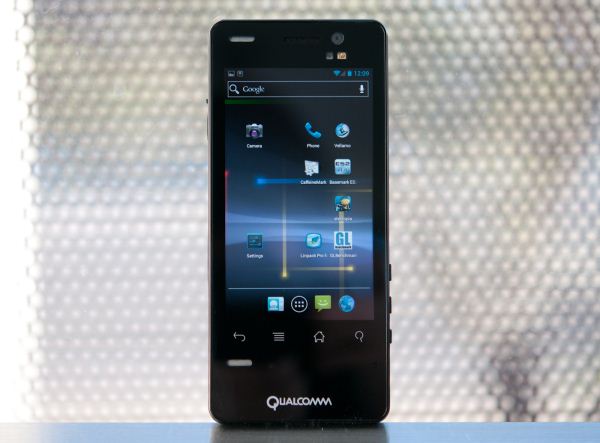Qualcomm Snapdragon S4 (Krait) Performance Preview - 1.5 GHz MSM8960 MDP and Adreno 225 Benchmarks
by Brian Klug & Anand Lal Shimpi on February 21, 2012 3:01 AM EST- Posted in
- Smartphones
- Snapdragon
- Qualcomm
- Adreno
- Krait
- Mobile
Final Words
It goes without saying that MSM8960 is a hugely important SoC release for Qualcomm. It's the first release with Qualcomm's new Krait CPU architecture, an entirely new cellular baseband with support for nearly every air interface, and is manufactured on TSMC's 28nm process. It says something that we're able to hold 28nm TSMC silicon in our hands in the form of the MDP, and it's only a matter of time before we start seeing Krait show up in devices in 2012.
We've gone over basically all of the benchmarks available to us on Android right now, and yet subjective performance impressions are still valuable. The MDP8960 is the absolute fastest we've seen Ice Cream Sandwich thus far - the UI is absolutely butter smooth everywhere, and web browsing in either Chrome or the stock Android Browser is also the smoothest we've seen it. There's no stutter bringing up the application switcher, or taking screenshots, two places that 4.0.3 still drops frames on the Galaxy Nexus.
Krait offers another generational leap in mobile SoC performance. The range of impact depends entirely on the workload but it's safe to say that it's noticeable. The GPU side of the equation has been improved tremendously as well, although that's mostly a function of 28nm enabling a very high clock speed for Qualcomm's Adreno 225. We are eager to see what the Adreno 3xx GPUs that will pair up with future Krait SoCs can do.
The big unknowns today are power consumption and the performance of shipping devices. While we were able to provide power numbers using Qualcomm's handy Trepn tool, we couldn't produce a reference point on older silicon. The move to 28nm and a second generation of cellular basebands has generally been heralded as being the answer to our battery life issues, particularly with LTE. It remains to be seen just how much of an improvement we'll see there. Knowing how much power MSM8960's cellular architecture uses is especially relevant when you consider that MDM9615 includes the exact same modem as MSM8960.
These initial results look extremely promising, however. Krait based devices should begin shipping sometime next quarter, the wait is almost over.











86 Comments
View All Comments
Exophase - Wednesday, February 22, 2012 - link
That 750mW is not for the entire core, it's for the CPU with hyperthreading disabled plus L2 cache. Intel said enabling hyperthreading adds some further draw to it, something between 10-20% as far as I can remember.hova2012 - Tuesday, February 21, 2012 - link
I'm pretty sure I'm not the only one who is disappointed that the Krait dual core wasn't compared to intel's upcoming atom socs. Isn't this the generation that was supposed to bring arm up to parity with intel's chip? All in all this was a great article, sets the standard for tech reviews.Exophase - Wednesday, February 22, 2012 - link
Hard to give a good comparison when you don't have direct access to Intel's reference hardware, or if you do you aren't under liberty to publish benchmarking results.Lucian Armasu - Tuesday, February 21, 2012 - link
Why are the MDP versions of Qualcomm's chips significantly higher performance than the ones in the market, like the one in the HTC Rezound? Doesn't that seem strange to you?Could it be that Qualcomm's MDP chips are meant to run significantly faster to show good benchmarks, but then they weaken them in shipping products? Or is there something I'm missing?
Death666Angel - Tuesday, February 21, 2012 - link
How would they weaken them in shipping products?Do you have more comparisons between the MDP and shipping phones apart from the Rezound?
I would look to different governor settings, different software builts and different settings as an explanation before jumping into conspiracy territory. :D
Lucian Armasu - Tuesday, February 21, 2012 - link
I was just looking at the score charts Anandtech provided. Look at these 2 for example:http://images.anandtech.com/graphs/graph5559/44380...
http://images.anandtech.com/graphs/graph5559/44383...
Why does the MDP MSM8660 have significantly higher (double) performance than the presumably "same" MSM8660 chip in HTC Rezound? Isn't the MDP MSM8660 supposed to showcase the same MSM8660 that will go into the market?
I'd love for Brian or Anand to prove me wrong here with some kind of technical explanation, but until then I'll just assume it's Qualcomm being sneaky and trying to manipulate the public's opinion about their chips.
ndk - Tuesday, February 21, 2012 - link
The article clearly mentions that MDP 8660 was running with governor settings at "performance". I can't imagine HTC or any other company shipping their products with this setting on.Brian Klug - Tuesday, February 21, 2012 - link
NDK is correct about governor being the reason, and I found that result interesting as well.It's clear to me at least that the governor settings on the Rezound are fairly conservative, and that even with a workload that's supposed to completely load both cores (mashing the multi-threaded test button in linpack pro), you never really get better that single threaded performance.
-Brian
infra_red_dude - Tuesday, February 21, 2012 - link
All the overlay customization by OEM and the power management code in the device kernel does have a detrimental effect on the device's performance.phoenix_rizzen - Tuesday, February 21, 2012 - link
Not to mention versions of Android. The MDP is running 4.0.3. What's the Rezound running?